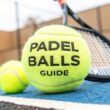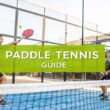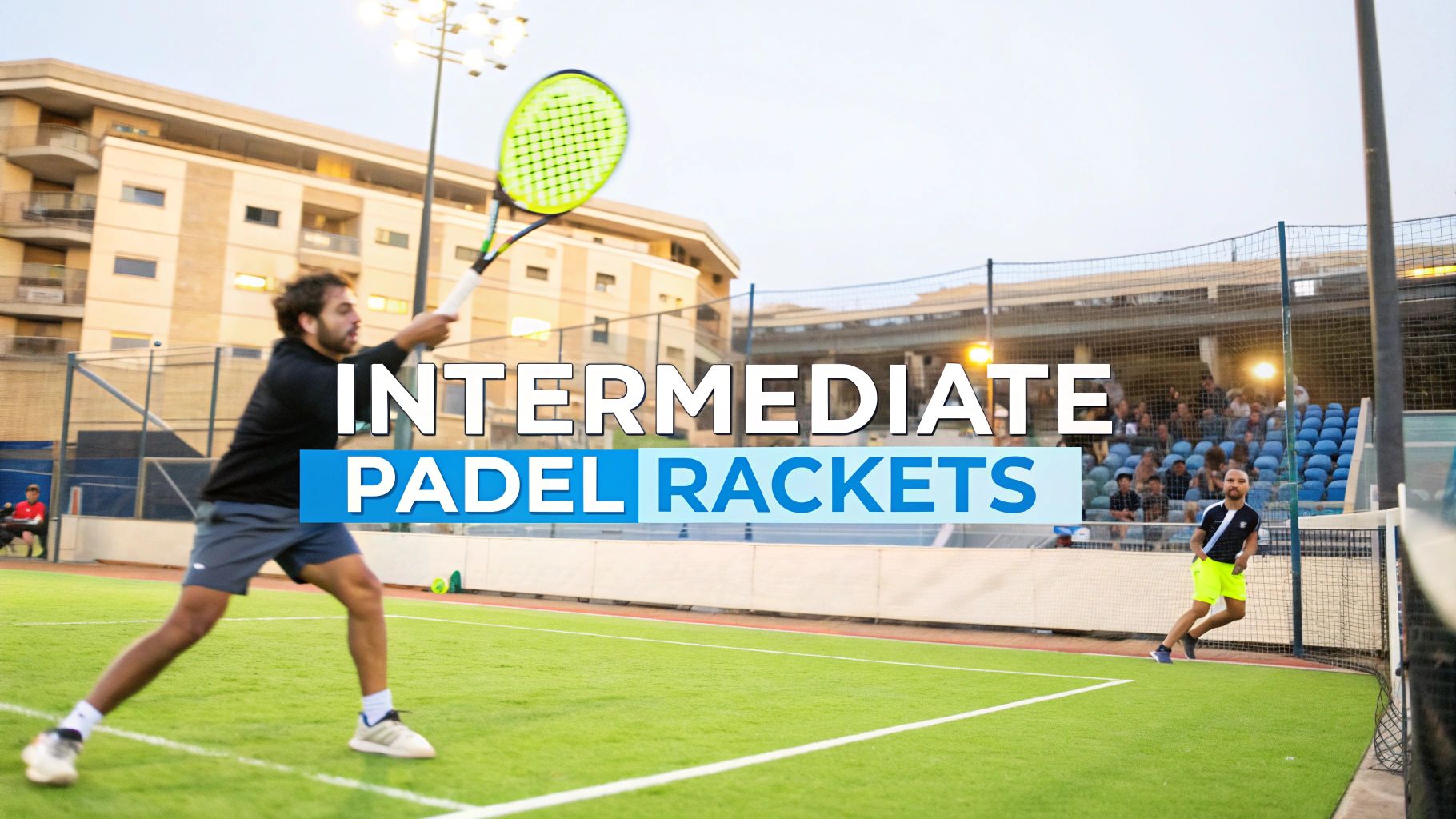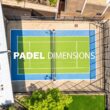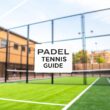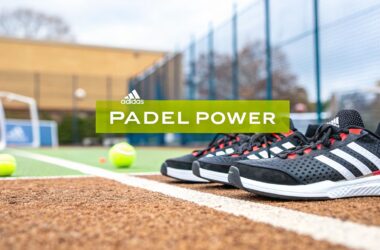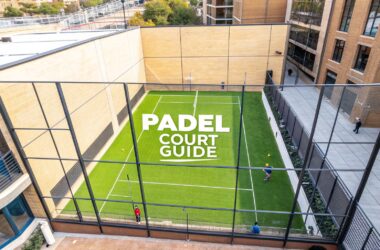When you're ready to move on from your first padel racket, you've hit a major milestone. As an intermediate player, you need a racket that can keep up with your developing skills—one that lets you crank up the power and spin without ditching the control you've worked so hard to build. You're no longer just trying to get the ball back; you're starting to build points with a real strategy.
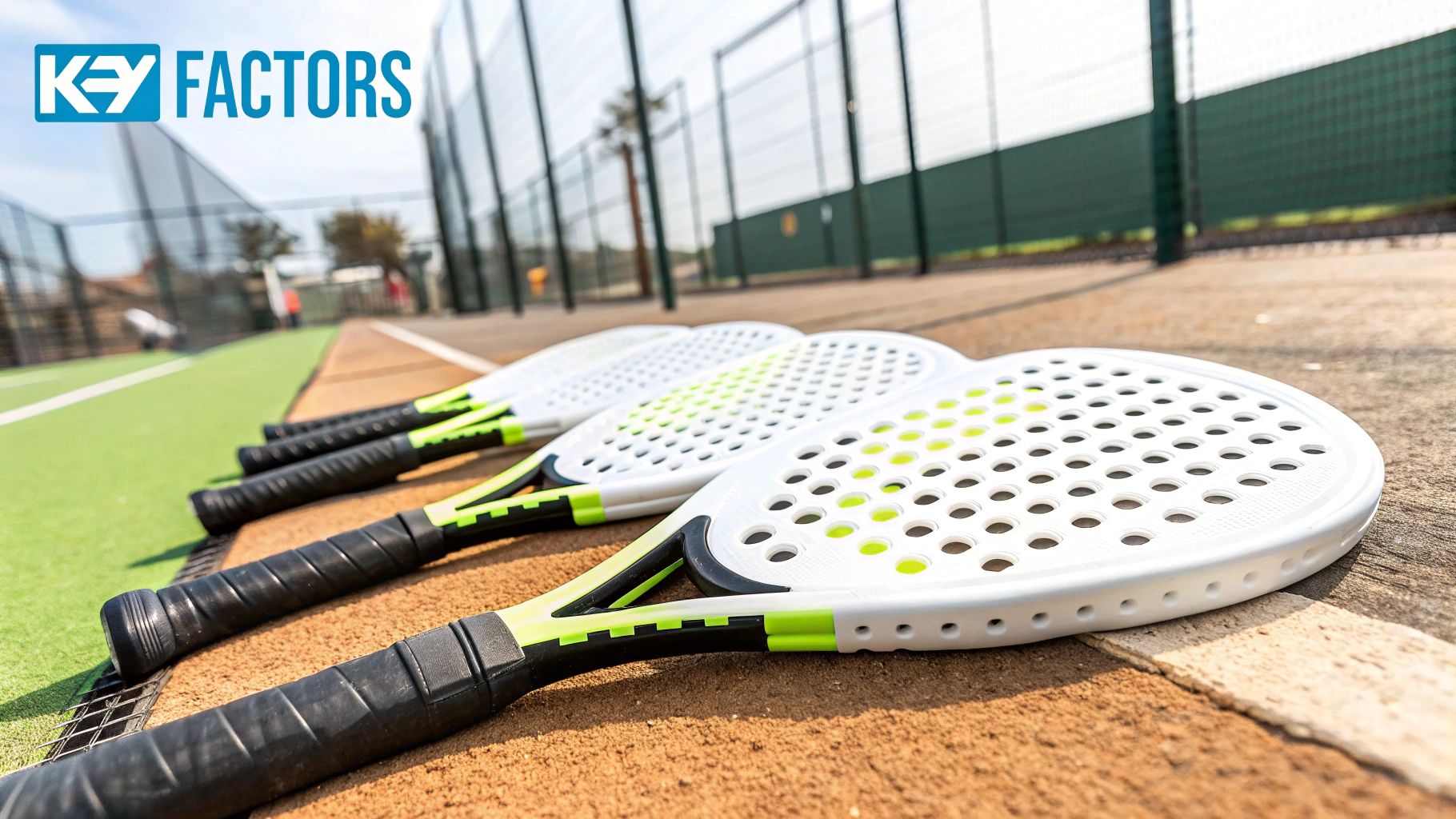
The market for these rackets is exploding. The global padel racket market is expected to jump from about USD 134.7 million in 2025 to a massive USD 312.9 million by 2032. A big driver of that growth is the teardrop-shaped racket, which is on track to snag a 36.3% market share in 2025. Why? Because it hits that perfect sweet spot of power and control that intermediate players are looking for.
What to Look For in an Intermediate Racket
As you start comparing rackets, a few key features will keep popping up for players at your level. Getting a handle on these will make your decision a whole lot easier and ensure you pick something that actually helps your game.
- Shape: The teardrop is almost always the right call here. It gives you a bigger sweet spot than a diamond racket and more firepower than a round one, making it the ultimate all-rounder.
- Balance: A medium (or even) balance is your friend. It keeps the racket nimble enough for quick reactions at the net but still has enough weight behind the ball for solid overheads.
- Core Material: Look for a medium-density foam, like a soft EVA. This gives you a great feel on contact, soaks up vibrations to save your arm, and helps the ball pop off the racket face.
The perfect intermediate racket shouldn't feel like a foreign object. It should feel like a natural extension of your arm, giving you the confidence to pull off the shots you see in your head.
Why This Upgrade Is a Big Deal
Picking the right racket at this stage is a game-changer for your development. A good racket will give you the stability and feel you need to start mastering trickier shots like the bandeja and vibora. It’s the tool that helps you stop reacting to your opponent and start dictating the pace of the match.
For more news and updates on padel rackets, you can check out our other articles here: https://padelrumors.pages.dev/news/padel-racket/
Understanding Racket Specs for Your Game
Diving into the technical specs of a padel racket can feel a bit like learning a new language. But for an intermediate player, this is exactly how you unlock the next level of your game. Getting a handle on how a racket's shape, weight, balance, and core materials work together is what separates a passive player from one who can actively pick a tool that perfectly suits their style. This knowledge is power—it lets you look at any product description and know precisely how that racket will feel and perform on the court.
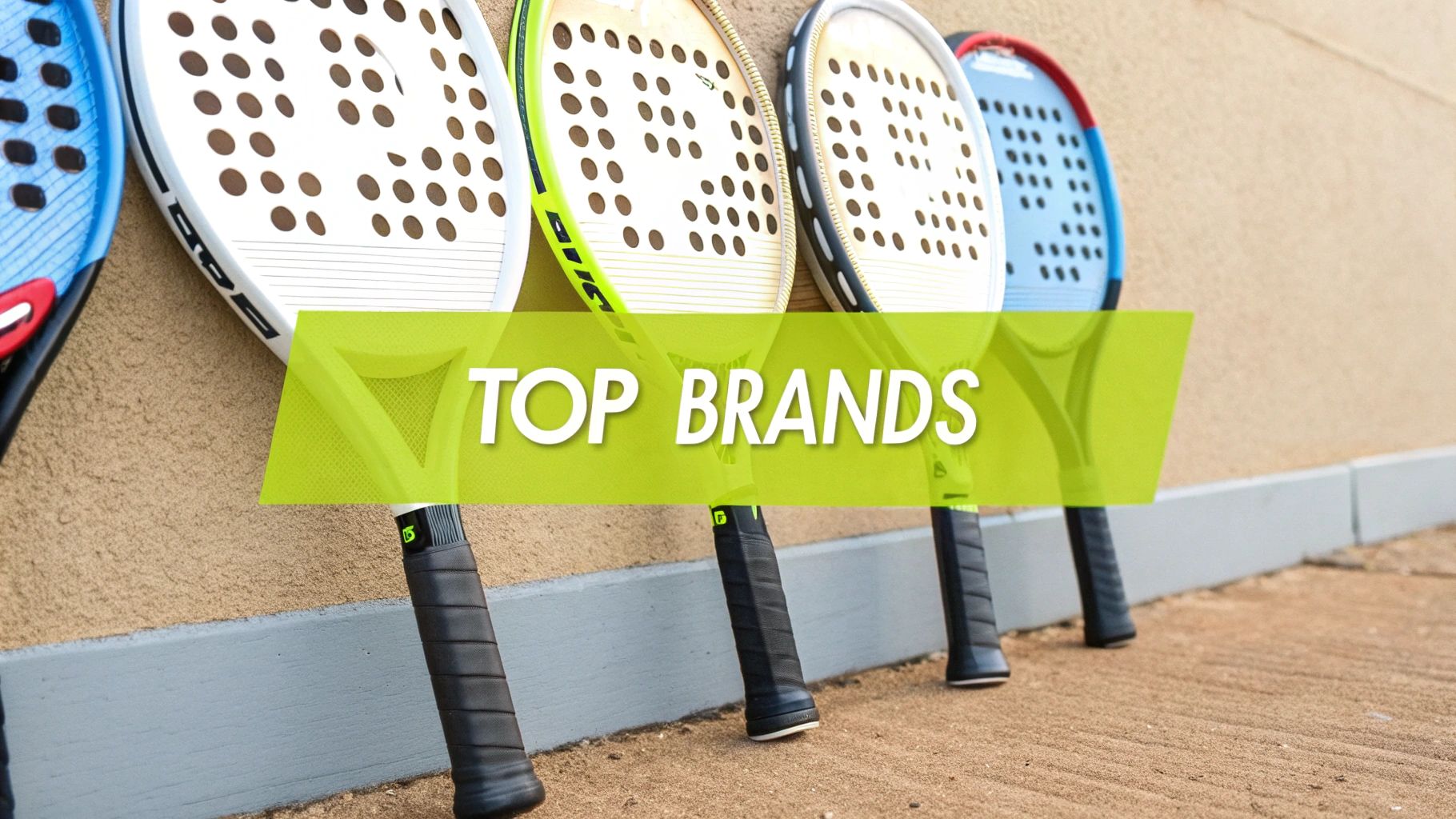
This isn't just about memorizing terms. It’s about translating those specs into real-world advantages on the court. For example, knowing how a specific foam density absorbs vibrations can help you pick a racket that prevents tennis elbow, keeping you playing longer. In the same way, understanding balance points can mean the difference between winning and losing a fast exchange at the net.
The Decisive Factor of Racket Shape
You could argue that the shape of a padel racket is its single most defining feature. It directly impacts the size and location of the sweet spot, and for intermediates, striking the right balance between forgiveness and power is everything.
- Round Shape: These rackets have the biggest, most centered sweet spot you can get. That makes them incredibly forgiving and easy to control, which is why they’re the go-to recommendation for beginners. The downside? An intermediate player might find them lacking the punch needed for those match-winning smashes.
- Diamond Shape: The complete opposite of a round racket. Diamond shapes have a smaller sweet spot located high up on the face. This design is built purely for power but is notoriously unforgiving on off-center hits. It's really better suited for advanced players with rock-solid technique.
- Teardrop Shape: This is the sweet spot for most intermediate players. It’s a fantastic blend of the other two shapes, offering a generous sweet spot that sits higher than a round racket's but is far more forgiving than a diamond's. This all-around performance is why it's a top choice for players developing their all-court game.
The market for intermediate padel rackets is fiercely competitive, with brands focusing on that perfect mix of power, control, and comfort. Data consistently shows a strong preference for teardrop and round shapes at this level. They simply offer a better balance of sweet spot size and weight distribution compared to the more demanding diamond shapes.
A teardrop racket is like a multitool for the intermediate player. It provides enough control for precise lobs from the back of the court and enough power to put away a volley at the net.
Weight and Balance: The Feel of the Game
Beyond shape, a racket's weight and balance are what truly dictate its maneuverability and stability. These two specs work hand-in-hand to create the racket's unique "feel" in your hand. Most intermediate rackets fall somewhere between 360 and 375 grams.
A lighter racket (around 360-365g) is much easier to swing quickly. This is a huge plus for fast reactions at the net and helps reduce arm fatigue over a long match. The trade-off is that it might lack the mass to absorb and return powerful shots from your opponents effectively.
On the other hand, a heavier racket (around 370-375g) gives you more stability and power. It feels solid on impact and helps you drive the ball with more authority, but it can be slower to get into position and more tiring on your arm.
The balance point is just as critical.
- Head-Light Balance: The weight is shifted down towards the handle. This boosts maneuverability and control, making it easier to prepare your shots and react in a flash.
- Head-Heavy Balance: Here, the weight is concentrated at the top of the racket. This generates more momentum and raw power, especially on smashes, but it can feel a bit unwieldy and hard to manage.
- Even Balance: This is the middle ground, offering a good mix of both power and control without leaning too far in either direction. Most intermediate rackets aim for an even or slightly head-light balance to provide that versatile feel.
Core Materials: The Heart of the Racket
The final piece of the puzzle is the racket's core, which is usually made from either EVA foam or Polyethylene foam. This material determines the racket’s touch and what you feel when the ball makes contact.
EVA Foam is the most common core you'll find. It comes in different densities:
- Soft EVA: This gives you excellent ball output (the ball really flies off the racket) and great vibration absorption for a comfortable feel. It's perfect for defensive players and anyone with a sensitive arm.
- Hard EVA: This provides more power and control, but you need to generate your own swing speed to get the most out of it. It offers a very direct, crisp feel but is much less forgiving on mishits.
Polyethylene Foam is significantly softer than EVA. It creates a "trampoline" effect that launches the ball with minimal effort from you. While it's incredibly comfortable, some players feel they have less direct control over where the ball goes.
For a deeper dive into how shapes and materials combine, you can check out our guide on the different types of padel rackets.
A Closer Look at the Top Intermediate Padel Rackets
Trying to find the right intermediate padel racket can feel like you're lost in a sea of tech specs and marketing jargon. Every brand promises the perfect mix of power and control, but what does that actually mean when you're on the court? The real key is to look past the spec sheet and understand how a racket will feel and perform during a real match.
As an intermediate player, you need a racket that helps your game grow. It should support you whether you're defending with a controlled bandeja off the back glass or stepping in for a decisive smash at the net. Let's break down some of the best options out there and see how their unique designs translate to actual on-court performance, helping you find the one that fits your game.
Head Speed Motion 2024
The Head Speed Motion 2024 is a fantastic choice for the all-court player who thrives on versatility. It's built with Head's Auxetic technology, which gives you an incredible amount of feel and feedback on every single shot. Its teardrop shape creates a great balance between a forgiving sweet spot for those off-center hits and enough pop to keep your opponents honest.
Weighing in at around 360 grams, it’s one of the lighter rackets you'll find in this category. That low weight makes it incredibly easy to handle, which is a massive plus during those quick-fire volleys at the net or when you need to react fast to a tricky shot. The hybrid hitting surface, blending carbon and fiberglass, provides a crisp feel without being harsh on the arm.
How It Plays on Court
This racket is a star in defensive situations. Its lightness helps you prepare your shots quicker, making tough digs and deep lobs feel much more effortless. Up at the net, that same maneuverability gives you lightning-fast volleys and solid blocks. It might not have the raw, brute force of a heavy, diamond-shaped racket, but it’s got plenty of punch to finish points when you get the chance.
Who Is It For? The Speed Motion is perfect for the fast-moving player who covers the whole court and values speed and feel over pure power. If your game is built on quick reactions, solid defense, and aggressive net play, this racket will feel like it was made for you.
Bullpadel Vertex 04 Comfort 2024
If you're looking to inject more power into your game without the unforgiving feel of a pro-level racket, the Bullpadel Vertex 04 Comfort is a brilliant option. Think of it as a more user-friendly version of the famous Vertex racket. It has a diamond shape, which naturally shifts the balance towards the head for more power in your smashes and overheads.
Bullpadel has cleverly added features to make it work for intermediates. The face uses a Fibrix hybrid fiber, mixing carbon and fiberglass for a more elastic feel that boosts comfort and helps the ball fly off the racket. Inside, the MultiEva core uses different densities to adapt to both slow defensive shots and fast attacks, giving you a responsive feel no matter the situation.
How It Plays on Court
You'll immediately notice the difference when you hit smashes, viboras, and bandejas. The head-heavy balance helps you whip the racket through the air, generating serious power with less effort. While the diamond shape means the sweet spot is smaller and higher up on the face, the Fibrix surface adds a layer of forgiveness that intermediates will be thankful for. You’ll need a bit more precision in defense, but when you connect well, your returns will be powerful.
This image really helps to understand the relationship between a racket's balance and its performance characteristics.
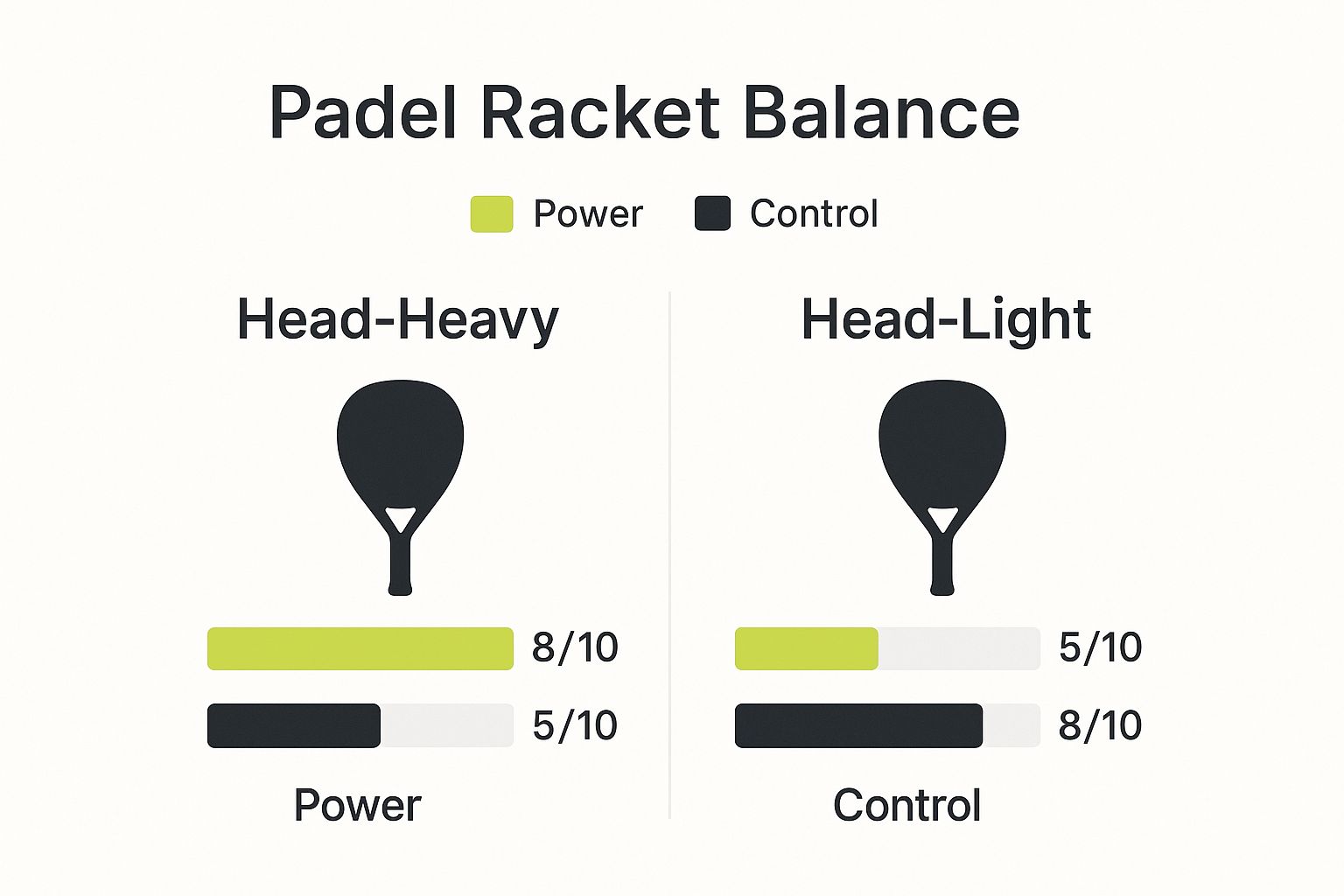
It's clear that a head-heavy balance is all about maximizing power, whereas a head-light balance gives you more control and makes the racket easier to handle.
Who Is It For? This racket is tailor-made for the aggressive intermediate player who wants to start taking control of points from the back of the court. If your fundamentals are solid and you're ready to develop a more powerful attacking game, the Vertex 04 Comfort is a fantastic next step.
NOX AT10 Genius 18K 2024 by Agustin Tapia
The NOX AT10 Genius 18K is a true icon for a reason—it delivers perfectly balanced performance, making it a favorite for a huge range of players, intermediates included. Developed with pro player Agustin Tapia, it has a teardrop shape and a medium balance, hitting that sweet spot as a genuine all-rounder. Its main talking point is the 18K Carbon face, which offers a much stiffer, more direct feel than softer materials.
That stiffness is your ticket to amazing precision and power, but you have to bring the swing speed to unlock it. The high-density HR3 Core works with the carbon face to give you quick power transfer and recovery. NOX also included an anti-vibration system, which does a great job of soaking up impact and making it comfortable to play with, despite its firm build.
How It Plays on Court
The AT10 Genius feels incredibly stable from the baseline. It gives you the confidence to hit through the ball, producing heavy, well-controlled groundstrokes. The rough texture on the face is a massive bonus, letting you put some serious spin on your slice shots and topspin lobs. At the net, it feels solid and precise, perfect for hitting sharp volleys into the corners. It's less forgiving than a soft racket on mishits, so it definitely rewards good technique.
Who Is It For? The NOX AT10 Genius 18K is designed for the intermediate player with solid technique who is on the verge of becoming an advanced player. If you already have a well-developed swing and you prioritize precision, spin, and a direct feel, this racket will take your game to the next level.
Babolat Veron Technical 2024
Babolat’s Veron line is all about bridging the gap between their easy-to-play rackets and their elite Viper series. The Veron Technical, as the name implies, is for the attacker whose game plan is to win points with power. It has a distinct diamond shape with a head-heavy balance, a combination purely focused on hitting the ball hard.
The secret sauce that makes it work for intermediates is the Carbon Flex face. This is a smart blend of carbon and fiberglass, giving you the explosive pop of carbon with the easy power and comfort of fiberglass. This mix makes the racket more forgiving than a full-carbon beast, allowing developing players to tap into that power without it feeling like a brick.
How It Plays on Court
This racket is an absolute monster on overheads. Smashes feel explosive, and it makes it much easier to hit powerful shots that bring the ball back to your side or even send it out of the court. The head-heavy balance puts serious weight behind every shot, pushing your opponents back and creating openings. Defense is more of a challenge with this shape, but the Carbon Flex material gives you just enough feel to manage lobs and blocks once you get used to the balance. Choosing the best padel racket is always about these kinds of trade-offs.
Who Is It For? This one is for the intermediate player who is a born attacker. If your whole strategy is based on hitting hard, bullying opponents off the court, and finishing points with a bang, the Veron Technical gives you all the firepower you need in a surprisingly playable package.
Intermediate Padel Racket At-a-Glance Comparison
To make things even clearer, here’s a quick side-by-side look at how these rackets stack up. This table highlights their core specs and who they're best suited for, helping you narrow down your choice based on your personal playing style.
| Racket Model | Shape | Balance | Core Material | Primary Strength | Ideal Player Style |
|---|---|---|---|---|---|
| Head Speed Motion 2024 | Teardrop | Even | POWER FOAM | Maneuverability & Feel | Fast-moving all-courter |
| Bullpadel Vertex 04 Comfort | Diamond | Head-Heavy | MultiEva | Accessible Power | Aggressive developing attacker |
| NOX AT10 Genius 18K | Teardrop | Medium | HR3 Core | Precision & Spin | Technical player with good form |
| Babolat Veron Technical | Diamond | Head-Heavy | Black EVA | Explosive Power & Comfort | Attacker who loves to smash |
Ultimately, each of these rackets offers a unique feel and performance profile. The best one for you comes down to what you value most on the court—whether it’s lightning-fast handling, raw power, or pinpoint precision.
Matching a Racket to Your Playing Style
Choosing the right padel racket isn't just about comparing specs on a page. The real goal is to find a racket that clicks with your game, amplifying what you do well and shoring up your weak spots. It should feel like an extension of your arm, not just a piece of equipment.
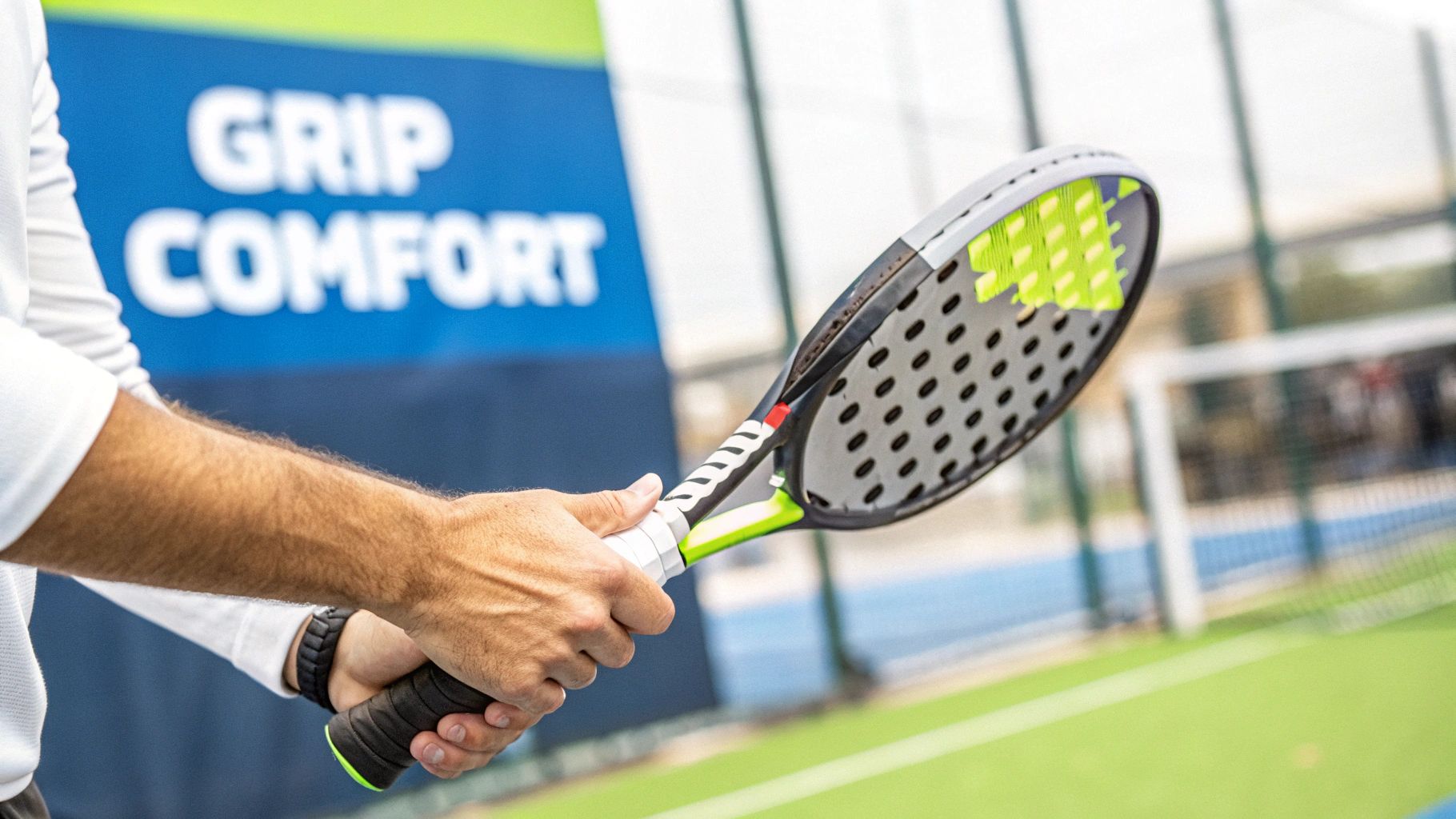
To get there, you first need to figure out what kind of player you are. Are you the one grinding out points with patience and precision, or do you live to attack and end points with power? Being honest about your style is the single most important step in finding the perfect match.
The Consistent Defender
The Consistent Defender is the rock of any partnership. You win points by being a wall, wearing down opponents with perfectly placed lobs and deep, steady shots. Your game isn't about flashy winners; it's about forcing the other team to make a mistake.
For this style, control is king. You need a racket that gives you pinpoint accuracy and has a big, forgiving sweet spot to keep you consistent, even when you're under the gun.
Racket recommendations for this style:
- Shape: A round shape is your best friend. It gives you the largest, most centered sweet spot, which is exactly what you need to make sure your defensive shots go right where you want them.
- Balance: Look for a low balance (head-light). This makes the racket super maneuverable, helping you react quickly to smashes and get under the ball for those crucial defensive lobs.
- Core: A soft EVA foam core is perfect. It gives you great ball output, meaning the ball springs off the racket face without you having to swing hard—ideal for sending back deep, defensive shots with less effort.
The Aggressive All-Courter
The Aggressive All-Courter is a dynamic force on the court. You're comfortable playing from the back, but you're always hunting for a chance to charge the net and finish the point. Your game is a mix of controlled defense and explosive attacks, using the bandeja and vibora to set up easy volleys.
You need a racket that can do a bit of everything—enough control for the defensive rallies but with the firepower to be a threat when you attack. This versatility is what lets you adapt and take charge of any point.
A versatile racket is crucial for the all-courter. It must provide enough power to attack without sacrificing the control needed for delicate drop shots or precise lobs, making it a true jack-of-all-trades.
Racket recommendations for this style:
- Shape: A teardrop shape is the clear choice here. It's the perfect blend of a round racket's control and a diamond's power, with a sweet spot that sits a bit higher on the face for better leverage on attacking shots.
- Balance: An even or medium balance strikes the perfect compromise. It’s stable enough for big hits but still nimble enough for those fast exchanges up at the net.
- Core: A medium-density EVA foam or a hybrid core is your best bet. This provides a crisp, responsive feel, giving you a great connection with the ball for both powerful smashes and delicate touch shots.
The demand for these adaptable rackets is huge, especially in Europe, which accounts for a massive 43.7% of the global padel racket market. The love for racquet sports in countries like Spain and Italy has created a big appetite for intermediate rackets that offer this kind of balance for different playing styles. You can read more about the growing padel market and its trends.
Common Mistakes When Upgrading Your Racket
Moving up to your next racket is an exciting part of the padel journey, but it’s also a minefield of potential mistakes. The right choice can seriously level up your game. A bad one, however, can stop your progress cold or even lead to an injury.
Knowing the most common traps intermediate players fall into is the first step toward making a smart buy. It's so easy to get sucked in by a pro-level racket, thinking it's a shortcut to pro-level skills. That’s probably the biggest—and most expensive—mistake you can make. The best padel rackets for intermediate players are built to help you grow, not demand perfection right out of the box.
Choosing a Racket That Is Way Too Advanced
You see a pro player absolutely crushing a smash with a stiff, diamond-shaped racket and think, "I need that." We've all been there. The problem is, those rackets are built for elite athletes with near-perfect technique and serious physical conditioning. For an intermediate player, that kind of jump almost always backfires.
A stiff, head-heavy racket has a tiny sweet spot and demands a powerful, perfectly timed swing. Miss that, and you're left with frustrating mishits, zero control, and harsh vibrations that can lead straight to injuries like tennis elbow. Your technique should pick your racket, not the other way around.
The goal is to find a racket that makes playing easier and more effective for you right now. Battling a racket that’s too difficult just builds bad habits and kills your confidence, slowing down your actual improvement.
Chasing Power and Forgetting Control
As you get better, you naturally want to hit the ball harder. This sends a lot of players straight to rackets designed for pure power, but they forget that most points in padel are won with strategy and control, not just raw speed.
All the power in the world is useless if you can't keep the ball in the court. At the intermediate level, matches are usually decided by unforced errors, not by incredible winning shots. A racket that gives you a good mix of power and control is what helps you build points, outsmart your opponents, and win matches with smart, consistent play.
- Focus on Consistency: A racket with a bigger sweet spot and better feel will help you cut down on those simple mistakes.
- Build Points Strategically: Control is what lets you nail those crucial shots like lobs and chiquitas.
- Earn Your Power: Work on your technique first. Once your form is solid, the power will come naturally.
Buying Based on Who Plays With It
Pro players use rackets that are often custom-made or heavily modified to fit their exact style and strength. Buying a racket just because your favorite pro uses it is like buying elite marathon shoes for a quick jog around the block—it’s just not made for what you’re doing.
A pro’s name on a racket is pure marketing. It's not a personal recommendation for your game. Instead of looking at the pros, look at your own game.
- Know Your Strengths and Weaknesses: Are you a solid defender who needs more touch at the net, or an aggressive player who wants a little more pop?
- Think About Your Body: If your arm gets tired easily, a lighter racket could be a much better fit.
- Test Them Out If You Can: Nothing beats hitting with a few different rackets on the court. You'll know right away how they feel in a real game.
Making a decision based on your own game is the best investment you can make for your padel future.
Answering Your Intermediate Racket Questions
Alright, let's tackle some of the practical questions that always pop up when you're on the verge of buying a new racket. You've done the research, you understand the specs, but it's those final few details that can make or break your decision.
Getting these last points cleared up is what separates a good purchase from a great one. We'll go through the most common hang-ups intermediate players have, so you can walk away feeling confident and ready to hit the court with the right gear in hand.
When Should I Upgrade My Racket?
This is a classic dilemma. The simplest answer? You'll know it's time to upgrade when your racket feels like it's holding you back. If your technique is getting more solid and you’re placing the ball consistently, but you just can't seem to generate the power you want on aggressive shots, your racket is probably the bottleneck.
Another big tell is when you start pulling off more advanced shots like the bandeja or vibora. If the racket feels sluggish or you're struggling to get the right feel for spin and placement, it's time to move on. An intermediate model will give you that blend of stiffness and responsiveness you need to really make those shots count.
Should I Choose Carbon Fiber or Fiberglass?
This is all about feel and performance. There’s no "better" material here; it's about what you want the racket to do for you.
Rackets with a fiberglass face feel softer and more flexible. This gives you a really comfortable hitting sensation and fantastic ball output—meaning the ball just flies off the face without you having to swing out of your shoes. If you value touch, control, and keeping your arm happy, fiberglass is a great choice.
Carbon fiber, on the other hand, is much stiffer and more rigid. For players who can generate their own swing speed, this translates directly into more power and pinpoint precision. Many of the top intermediate rackets use a hybrid construction—a carbon frame for stability with fiberglass faces for feel—to give you a bit of both.
The decision often comes down to this: Do you want the racket to help you generate power (fiberglass), or do you want to provide the power and have the racket deliver precision (carbon fiber)?
Does a Higher Price Mean Better Performance?
For an intermediate player, the answer is almost always a hard no. The priciest rackets on the market are built for professional athletes—players with near-perfect technique and incredible physical strength. Those models are brutally stiff, often heavy, and balanced in ways that are extremely difficult for a developing player to handle.
Trying to wield a pro-level racket before you're ready won't just stall your progress; its unforgiving nature can also lead to injuries. The best racket is always the one that complements your current skill level. A well-chosen, mid-range intermediate racket will help you improve far more than a top-of-the-line pro model ever could.
At Padel Rumors, we provide the latest news, in-depth guides, and expert reviews to support every aspect of your padel journey. Explore our resources to find the perfect gear and elevate your game at https://padelrumors.pages.dev.


